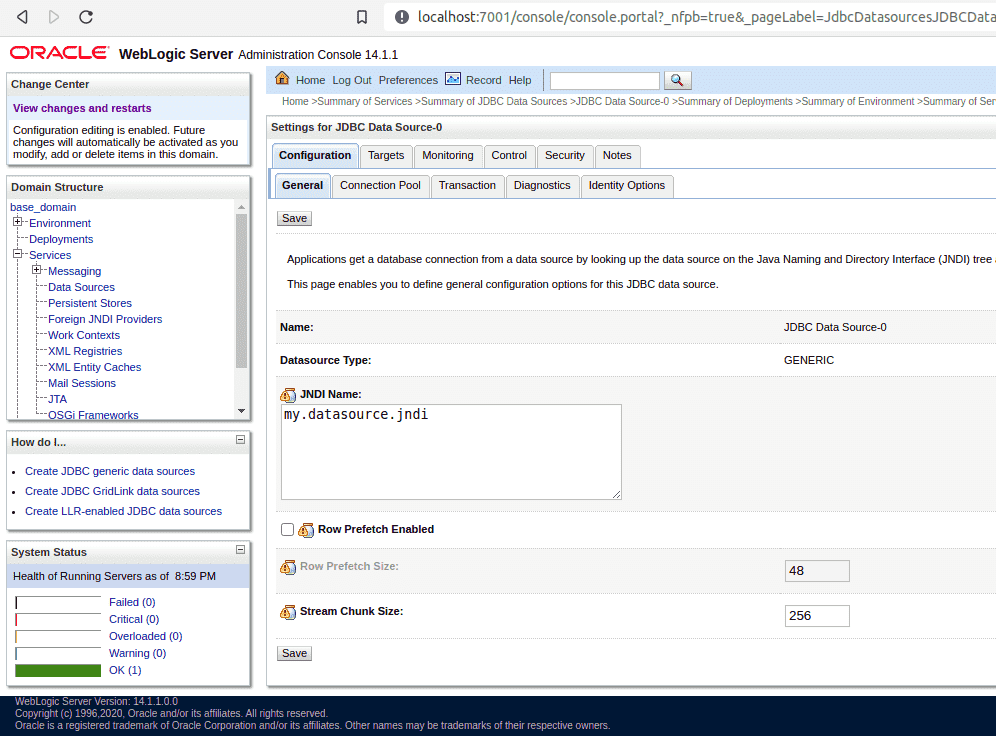WebLogic client Data Source lookup
When creating an application in EJB technology for WebLogic servers, access to the database is usually performed through the EJB beans. Sometimes, however, from the SE client point of view, we may need some direct access to the database, e.g. to verify our system or integration tests.
The basic element providing the connection to the database is the Data Source configured on WebLogic.
We can always find a reference to the Data Source via InitialContext or the @Resource annotation, assuming that we are in a container-managed seed.
WebLogic 12.x client DataSource
However, to obtain a reference to the DataSource managed by the WebLogic 12.x server from the client level, there are some additional prerequisites. We will need the wlfullclient.jar library. By default, this library cannot be found in the Maven repository, and we have to build it on our own, from the WebLogic installation directory. How to build the library is described in the documentation:
- Find the
WL_HOME/server/libdirectory. - Build the library:
java -jar wljarbuilder.jar. - Add the library to the classpath. Apart from playing with the
-cpparameters, we can install it in a local repository and add it to Maven dependencies:
mvn install:install-file -Dfile=wlfullclient.jar -DgroupId=com.oracle -DartifactId=wlfullclient -Dversion=12.2.1.4 -Dpackaging=jar
<dependency>
<groupId>com.oracle</groupId>
<artifactId>wlfullclient</artifactId>
<version>12.2.1.4</version>
<scope>test</scope>
</dependency>
If you do not need stubs such as DataSource and are satisfied with basic EJB communication, you can use the wlthint3client.jar library from the same directory. Obtaining the reference looks pretty standard and is done through the InitialContext. As a context factory, we specify a WebLogic-specific factory. This class comes from the attached libraries.
import javax.naming.Context;
import javax.naming.InitialContext;
import javax.naming.NamingException;
import javax.sql.DataSource;
import java.sql.Connection;
import java.sql.PreparedStatement;
import java.sql.ResultSet;
import java.sql.SQLException;
import java.util.Properties;
import static org.hamcrest.CoreMatchers.equalTo;
import static org.hamcrest.MatcherAssert.assertThat;
import static org.junit.Assert.assertTrue;
public class DatabaseIT {
private final InitialContext context;
private final DataSource dataSource;
private final MyEjbService service;
public DatabaseIT() throws NamingException {
Properties env = new Properties();
env.put(Context.INITIAL_CONTEXT_FACTORY, "weblogic.jndi.WLInitialContextFactory");
env.put(Context.PROVIDER_URL, "t3://localhost:7001");
context = new InitialContext(env);
dataSource = (DataSource) context.lookup("my.datasource.jndi");
service = (MyEjbService) context.lookup("my.ejb.service.jndi");
}
@Test
public void testConnection() throws SQLException {
service.foo();
try (Connection connection = dataSource.getConnection();
PreparedStatement statement = connection.prepareStatement("SELECT * FROM DUAL");
ResultSet resultSet = statement.executeQuery()) {
assertTrue(resultSet.next());
assertThat(resultSet.getString(1), equalTo("X"));
}
}
}
Our integration test, or rather a system test, should finish successfully. You can find the proper JNDI name in the WebLogic console, by finding the connection configuration in the Services -> Data Sources tree:

Without the wlfullclient.jar library, we shouldn't be surprised by the following error when trying to get a reference to DataSource:
Cannot cast 'weblogic.jdbc.common.internal.RmiDataSource_12213_WLStub' to 'javax.sql.DataSource'
Furthermore, without any client library, we will not initialize the context due to the lack of weblogic.jndi.WLInitialContextFactory:
javax.naming.NoInitialContextException: Cannot instantiate class: weblogic.jndi.WLInitialContextFactory [Root exception is java.lang.ClassNotFoundException: weblogic.jndi.WLInitialContextFactory]
WebLogic 14.x client DataSource
The wlfullclient.jar library was already deprecated in version 12.2.1.3. Now in version 14.1.1.0 we won't find the wljarbuilder.jar, so we won't be able to build wlfullclient.jar anymore. We can use the wlfullclient.jar package built from one of the previous versions and hope for undocumented compatibility with version 14.1.1.0.
For example, using packages from versions 12.2.1.3 or 12.2.1.4, our test will pass without a problem, but with 12.1.3 we will get an error during the initialization of the context:
java.lang.NoClassDefFoundError: org/omg/PortableServer/POAPackage/ServantNotActive
A more compatible solution is to find libraries containing the necessary classes in the WL_HOME/modules directory. It is from this directory among others that wljarbuilder.jar builds wlfullclient.jar in previous versions. We can use the following command to find the classes we need:
for f in *.jar; do echo "$f: "; unzip -l $f | grep RmiDataSource; done
- the DataSource class will be found in WL_HOME/modules/com.bea.core.datasource6.jar.
Following the bread crumbs of new stack traces, we will find the missing classes:
java.lang.ClassNotFoundException: Failed to load class weblogic.jdbc.rmi.SerialConnection
- WL_HOME/modules/com.oracle.weblogic.jdbc.jar
java.lang.NoClassDefFoundError: weblogic/common/resourcepool/PooledResource
- WL_HOME/modules/com.bea.core.resourcepool.jar
These 3 packages and wlthint3client.jar will allow you to get a reference to DataSource managed by a WebLogic 14.1.1.0 from the client (Java SE), and successfully query the database.
If your container requires an authenticated connection, don't forget to set up the credentials through the Context.SECURITY_PRINCIPAL and Context.SECURITY_CREDENTIALS InitialContext properties.
